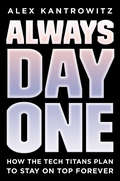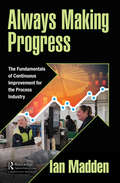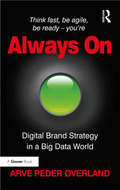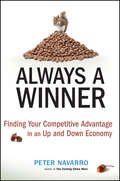- Table View
- List View
Altersvorsorge für Dummies (Für Dummies)
by Dieter HomburgSofort loslegen mit praktischen Schnellstartanleitungen Die Rentenlücke in sechseinfachen Schritten bestimmen und schließen Staatliche Förderung nutzen und so mit wenig Einsatz viel erreichen Entspannt und finanziell abgesichert ins Alter Fehlt Ihnen die Zeit, sich um Ihre Rente zu kümmern? Haben Sie das Gefühl, eh nicht genug beiseitelegen zu können, ohne Ihren derzeitigen Lebensstandard senken zu müssen? Sich rechtzeitig um die Altersvorsorge zu kümmern, ist ein Muss für jeden. Dieter Homburg unterstützt Sie dabei, dieses leidige Thema endlich anzugehen, einen Kassensturz zu machen, die Rentenlücke zu ermitteln und systematisch zu schließen – und das auch mit wenig Rücklagen, indem Sie Zuschüsse clever nutzen und geeignete Anlagemöglichkeiten auswählen. So können Sie entspannt älter werden und wissen: Sie sind gut versorgt! Sie erfahren Welche Anlagen mit dem geringsten Aufwand am meisten bringen Welche Vorsorgemöglichkeiten sich heute noch lohnen Wie Sie bestehende Lebensversicherungen auf den Prüfstand stellen
Altersvorsorge für Dummies (Für Dummies)
by Dieter HomburgMöchten auch Sie in Würde und selbstbestimmt bis ins hohe Alter leben? Aber wie, wo es heute fast keine Zinsen mehr gibt und die staatliche Rente auch nicht die Rettung sein wird? Richtig, in dem Sie es selbst in die Hand nehmen. Hierbei hilft Ihnen dieses Buch. In nur wenigen Stunden können Sie mithilfe einer praktischen Schnellstart-Anleitung Ihren konkreten Rentenfahrplan erstellen. Räumen Sie mit zu teuren und überflüssigen Versicherungen und Sparverträgen auf, senken Sie Ihre Steuerlast und zapfen Sie intelligent staatliche Fördertöpfe an. Das Ergebnis: mehr Altersvorsorge ohne einen Cent mehr auszugeben.
Alteryx Designer: Simplify and Automate Your Analytics
by Joshua BurkhowAnalytics projects are frequently long, drawn-out affairs, requiring multiple teams and skills to clean, join, and eventually turn data into analysis for timely decision-making. Alteryx Designer changes all of that. With this low-code, self-service, drag-and-drop workflow platform, new and experienced data and business analysts can deliver results in hours instead of weeks.This practical book shows you how to master all areas of Alteryx Designer quickly. Author and Alteryx ACE Joshua Burkhow starts with the basics of building a workflow, then introduces more than 200 tools for working with intermediate and advanced analytics functionality. With Alteryx Designer's all-in-one toolkit, you'll migrate from legacy analytics software or Excel with ease.Ready to work with data quickly and efficiently? This guide gets you started.Learn the fundamentals of cleaning, prepping, and analyzing data with Alteryx DesignerInstall, navigate, and quickly become competent with the Alteryx Designer layout and functionalityConstruct accurate, performant, reliable, and well-documented workflows that automate business processesLearn intermediate techniques using spatial analytics, reporting, and in-database toolsDive into advanced Alteryx capabilities, including predictive and machine learning toolsGet introduced to the entire Alteryx Analytic Process Automation (APA) Platform
Altius Golf and the Fighter Brand
by Robert J. Dolan Sunru YongAltius Golf is the clear leader in the golf ball market despite a long-term decline in the number of golfers and a drop in sales following the financial crisis. The firm has maintained its position by introducing generations of advanced, super-premium golf balls that allow their customers to emulate professional golfers. The company has been losing market share to lower-priced competitors and the CEO wants to introduce a new program called Elevate to foster the next generation of golfers. With Elevate, the firm will introduce a ball that is more forgiving and easier to drive for distance and offer it at a price 40% below the company's flagship brand. Elevate will be available through "off-course" channels such as golf specialty stores and big box retailers instead of "on-course" pro shops where the firm typically sells its products. The board of directors is divided on whether to support the decision. Students must perform a quantitative analysis of the CEO's proposal to understand the potential risks and gains before making a final recommendation.
Altoona State Investment Board & Bain Capital Fund XI
by Josh Lerner Ted BerkConsiders the decision faced by state pension fund manager Rod Calhoun as he decides whether to invest $200 million in Bain Capital's eleventh global buyout fund: Bain Capital Fund XI. For the fund, Bain was offering its limited partners a choice between three different fee structures: first, a "conventional" fee structure of a 1.5% management fee with 20% carried interest and a 7% preferred rate of return; second, a 1% management fee with 30% carried interest and a 7% preferred rate of return; or third, a 0.5% management fee, 30% carried interest, and a 0% preferred rate of return. Should Calhoun invest in Bain? If he should, which fee structure should Calhoun choose?
Altoona State Investment Board: December 2008
by Josh LernerRod Calhoun, the head of the Altoona State Investment Board's private equity investment program, considered the communication he had just received. It was from Permira, the leading European buyout fund, and concerned its fourth fund, to which Altoona had made a 100 million commitment. The memorandum offered investors a chance to reduce their commitment to Permira IV. This potential offer was an attractive one, as it would allow the state pension to address its "over-commitment problem," one that plagued many institutional investors. But the terms of the arrangement gave Calhoun pause.
Altoona State Investment Board: July 2012
by Josh Lerner Nathaniel BurbankConsiders the decision faced by state pension fund manager Rod Calhoun as he decides whether to invest $200 million in Bain Capital's eleventh global buyout fund: Bain Capital Fund XI. For the fund, Bain was offering its limited partners a choice between three different fee structures: first, a "conventional" fee structure of a 1.5% management fee with 20% carried interest and a 7% preferred rate of return; second, a 1% management fee with 30% carried interest and a 7% preferred rate of return; or third, a 0.5% management fee, 30% carried interest, and a 0% preferred rate of return. Should Calhoun invest in Bain? If he should, which fee structure should Calhoun choose?
Altos Ventures (A)
by Jo Tango Alys FerragamoIn December 2012, Altos Ventures General Partners Han Kim, Anthony Lee, and Ho Nam met to discuss the future of the firm. Altos had already adjusted its strategy multiple times. It began as a U.S.-focused venture capital investor whose first two funds were backed by a sole limited partner, a South Korean financial conglomerate. In late 2001, the partners made their first transformative decision, raising a fund from traditional institutional LPs to focus on bootstrapped technology companies. In 2008, Altos again refined its strategy, this time to fund similar capital-efficient companies but with more "explosive growth" potential. Now, in 2012, the firm was running out of capital and did not have the realized track record to raise another traditional institutional fund. They considered two options: raise a South Korea-focused VC fund or offer more co-investment opportunities to LPs through a "mini" fund. What should Altos do to stay afloat?
Altos Ventures (B)
by Jo Tango Alys FerragamoIn December 2021, Han Kim, Anthony Lee, and Ho Nam reflected on how far they had come since 2012. This B case provides an update on Altos Ventures' decision-making and performance since the events presented in the A case.
Altruism by Design: How To Effect Social Change as an Architect
by Adam R. WilmesAltruism by Design: How to Effect Social Change as an Architect is meant to prepare the individual designer – whether a student or practicing professional – for a career dedicated to serving communities in need through design and construction. It will help you understand the complexities, opportunities, and benefits of creating architecture that promotes social equality and community so that you can make a difference. What you'll learn: -How community-based studios can respond to natural disasters and economic conditions-How to build what you design-How to develop relationships with non-traditional clients-How to structure your career to be dedicated to social change and sustainable design-How to discover funding opportunities for projects in a not-for-profit firm-How to consider moral and financial aspects of your practice-How you can collaborate with other design professions to determine the future of the built environment Featuring detailed case studies, including work by Studio 804 and Pyotak Architects, and more than 100 color images; this book is essential reading for providing you with a viable path to altruistic design.
Alts Democratized
by Jessica Lynn Rabe Robert J. MartoranaA Comprehensive Review of the Liquid Alts Market and How '40 Act Products Can Enhance Client PortfoliosLiquid alternatives give investors access to hedge fund strategies with the benefits of '40 Act products: lower fees, higher liquidity, greater transparency, and improved tax efficiency.Alts Democratized is a hands-on guide that offers financial advisors and individual investors the tools and analysis to enhance client portfolios using alternative mutual funds and ETFs. Well-grounded in research and replete with more than 100 exhibits of Lipper data, Alts Democratized profiles the top ten funds in each of the eleven Lipper liquid alt classifications. This includes total net assets, fund flows, risk and return metrics, and the factor exposures that drive performance and help explain correlations to various forms of beta. Jessica Lynn Rabe and Robert J. Martorana, CFA, combine this research with a comprehensive framework for fund selection and portfolio construction to enhance the asset allocation process, facilitate portfolio customization, and manage client expectations.In addition, the book includes functional perspectives on issues pertinent to financial advisors such as fees, client suitability, and volatility management. This helps advisors apply the concepts to portfolios and offer actionable investment advice. The authors also interviewed executives at leading wealth management firms to provide color on industry trends and best practices.The companion website provides ancillary materials that reinforce and supplement the book, including:The authors' top ten takeawaysClassification cheat sheetPortfolio construction guide (full color)Talking points for clientsQ&A on liquid altsPresentation with all 118 exhibits from the book (full color) Alts Democratized comprises a complete resource for the advisor seeking new sources of alpha, diversification, and hedging of tail risks.
Aluminium Bahrain (Alba): The Pot Line 5 Expansion Project
by Aldo Sesia Benjamin C. EstyIn September 2002, Aluminium Bahrain (Alba) needed to decide how to finance its proposed $1.7 billion pot line. The company's financial adviser, Taylor De-Jongh (TDJ), had recommended Alba employ a multisourced financing strategy using as many as five sources of debt from international, regional, and local capital pools. TDJ believed that the strategy would generate competition among the lenders which, in turn, would save Alba millions in financing costs. But the multisourced financing strategy went against the grain of typical project financings in the Middle East and was not without its risks. Alba management must decide how many financing sources to use, which ones, and how much to get from each one. If the market rejects the multisourced financing strategy, the project might become tainted, which could jeopardize Alba's long-term growth objectives.
Aluminum Industry in 1994
by Kenneth CortsAfter reaching all-time highs in excess of $2,500 per ton in 1988 and 1989, aluminum prices fall dramatically in the early 1990s as the former Soviet Union begins exporting far larger quantities of metal. By the beginning of 1994, the price has hit all-time lows (in real terms) and stands at $1,110. The case contains data on world consumption by sector; an accompanying spreadsheet contains detailed cost data for the world's 157 smelters. Together, these allow a thorough supply and demand analysis that illuminates price fluctuations in this industry. A rewritten version of an earlier note.
Aluminum Smelting in South Africa: Alusaf's Hillside Project
by Kenneth CortsWith prices at all-time lows at the beginning of 1994, South Africa's sole primary aluminum producer--Alusaf--is considering building the world's largest greenfield smelter. Using cost estimates in this case, students can evaluate the relative cost position of this plant in the context of the cost data on other smelters provided in the spreadsheet accompanying "The Aluminum Industry in 1994." By building on the supply and demand analysis supported by that case, students can evaluate the profitability of this massive capital investment.
Alumni Leadership and University Excellence in Africa: The Case of Lagos Business School (Palgrave Studies in African Leadership)
by Henry O. OnukwubaFocusing on Lagos Business School (LBS) in Nigeria, this book explores the impact of strong alumni leadership on university excellence in Africa. Strong leadership is crucial to the success of educational institutions and great importance is placed on their effective governance and management. However, many institutions fail to realise the positive impact that a strong alumni body can have on university excellence. Drawing on definitions and theories of leadership, the author seeks to establish the significance of alumni in enhancing a university’s growth and development. Providing comprehensive analysis of LBS, this book is a unique resource for leaders of educational institutions, as well as those studying and teaching in African business schools.
Alumni-Netzwerke von Unternehmen: Theoretische und praktische Perspektiven (essentials)
by Christian SchwägerlChristian Schwägerl beschreibt, wie Alumni-Netzwerke in die Kommunikationsfunktion von Unternehmen integriert sind. Das essentialvermittelt Reflexionswissen über das Spannungsfeld der netzwerkkonstituierenden Peer-to-Peer-Kommunikation und der interessengeleiteten Kommunikation des Unternehmens mit den ehemaligen Mitarbeiterinnen und Mitarbeitern. Darüber hinaus stellt der Autor die Wertbeiträge dar, die Unternehmen auf ihrem Absatz-, Ressourcen- und Meinungsmarkt mithilfe von Alumni-Netzwerken erzielen können.
Alusaf Hillside Project
by John R. Wells Kenneth CortsThe aluminum industry has suffered from long periods of depressed prices and profits interspersed with relatively short-lived price and profit peaks. The case investigates why, this has occured, focusing on the decision Alusaf must make on whether to invest in a major new facility in the face of depressed aluminum prices. Courseware provides cost data on all the facilities in the industry to develop a supply curve. It also provides a supply and demand model that allows students to investigate: the drivers of average industry profitability and relative profitability of individual players in it; the impact of changes in demand over the economic cycle on the price of metal; the impact of different elasticities of demand on price and profitability; the impact of oligopolistic pricing on industry profitability; the impact of adding capacity on industry profitability; and the ability of a firm to preempt the aluminum market. A rewritten version of an earlier case.
Alvin Hansen: Seeking a Suitable Stabilization - An Academic Biography (Great Thinkers in Economics)
by Robert J. BiggThis book examines the academic life of Alvin Hansen and his contribution to modern economics. Through tracing the development of his early work and pre-Keynesian ideas, the influence of Keynes and the 1937-8 recession on the direction of his work is explored, particularly in relation to his theoretical backing of the New Deal and subsequent American policy. The subsequent chapters focus on his later work on secular stagnation, savings and investment, American Keynesianism, managing the post-war mixed economy and the often overlooked contributions to global questions and wider aspects of political economy and public policy. This book aims to highlight the intellectual influence and academic value of Alvin Hansen’s work. It will be relevant to students and researchers interested in economic policy, political economy, and the history of economic thought.
Always Day One: How the Tech Titans Plan to Stay on Top Forever
by Alex KantrowitzAn acclaimed tech reporter reveals the inner workings of Amazon, Facebook, Google, Apple, and Microsoft, showing how to compete with the tech titans using their own playbook.At Amazon, "Day One" is code for inventing like a startup, with little regard for legacy. Day Two is, in Jeff Bezos's own words, "stasis, followed by irrelevance, followed by excruciating, painful decline, followed by death."Most companies today are set up for Day Two. They build advantages and defend them fiercely, rather than invent the future. But Amazon and fellow tech titans Facebook, Google, and Microsoft are operating in Day One: they prioritize reinvention over tradition and collaboration over ownership. Through 130 interviews with insiders, from Mark Zuckerberg to hourly workers, Always Day One reveals the tech giants' blueprint for sustainable success in a business world where no advantage is safe. Companies today can spin up new products at record speed -- thanks to artificial intelligence and cloud computing -- and those who stand still will be picked apart. The tech giants remain dominant because they've built cultures that spark continual reinvention. It might sound radical, but those who don't act like it's always day one do so at their own peril. Kantrowitz uncovers the engine propelling the tech giants' continued dominance at a stage when most big companies begin to decline. And he shows the way forward for everyone who wants to compete with--and beat--the titans.
Always Making Progress: The Fundamentals of Continuous Improvement for the Process Industry
by Ian MaddenThis book guides process-industry professionals from the implementation of the basic foundations of Continuous Improvement (CI) through to an organization where CI is a “way of life” and a defining feature of the culture of the organization. The readers of this book are seeking solutions to such pressing issues as: • Eliminatng accidents and near misses. • Reducing customer complaints. • Improving customer delivery performance. • Elimination of accidents and near misses. • Reducing customer complaints. • Improving customer delivery performance. • Introducing new products. • Improving staff productivity. • Removing costs to meet the budget. • Dealing with absence and poor morale. • Improving staff retention. This book provides them with guidance on how to address issues in these areas in a way that enables improvements to be realized quickly but not at the expense of a long-term goal of a sustainable Continuous Improvement culture. In addition, this book presents the implementation of CI as a cyclical journey with no endpoint. The stages are ordered in a sequence that enables the reader to get started in their area of the company and build up the elements without the need for an overall organizational strategy at the beginning. Continuous Improvement is a vast subject with many takes on principles, approaches, and tools. This book is about how all the fundamentals of these areas fit together and, as such, covers only some of them. However, within the bibliography, I have signposted the books that have guided me during my career and which go into the principles, approaches, and tools further.
Always On
by Brian ChenAn intriguing, definitive analysis of technology's current all-in-one revolution, and a serious reflection on the social implications of an always on society.
Always On: Digital Brand Strategy in a Big Data World
by Arve ØverlandWhere do powerful strategies come from? How do some companies develop strategies that enable them to outperform others regardless of the state of their industry or the economic climate? How does a company get the essentials to work in regard to the company’s strategies, such as leadership buy-in and follow through on implementations and performance management, without being slow, rigid and check-box focused? These are some of the questions asked by Arve Peder Øverland in Always On: Digital Brand Strategy in a Big Data World. This book will provide an understanding of what it takes to develop, implement and run a digital strategy but it is not meant as a rigid process document that must be strictly adhered to. Companies have different needs and live in vastly different environments. The internal structure of an organization and the market in which it competes is not going to adapt to a digital strategy process, it must find a process and methodology that works best for it. With big data emerging as a standard framework for decision making, digital strategy and governance have taken on increased importance. It’s a given in today’s online marketplace that you are perceived as being always on. Make sure your governance programmes for your systems and platforms keep it that way. Think fast, be agile, be ready - you’re always on!
Always a Winner
by Peter Navarro"In much the same way that Good to Great uncovered hitherto hidden secrets of highly successful companies, Navarro's Always a Winner uses extensive research to reveal the overriding importance of learning how to forecast and strategically manage the business cycle for competitive advantage. In doing so, this book provocatively explores a critical aspect of successful management virtually untapped by the existing strategy literature." --Dan DiMicco, Chairman and Chief Executive Officer, Nucor Steel" Always a Winner is an important and timely guide to thriving in challenging economic times. Prof. Navarro deftly bridges the academic and business communities, showing corporate leaders how to read economic tea-leaves to anticipate business cycles. His "Master Cyclist" credo offers many practical tips and real-world case studies for steering companies through turbulent economic seas." --Mark Greene, Ph.D, Chief Executive Officer, FICO (Fair Isaac Corp.)"Navarro's Always a Winner shows why forecasting the economy with a ruler can be lethal for corporate executives and money managers. He demonstrates how to skillfully anticipate the ups and downs of the economy and successfully navigate through them. The current economic crisis clearly demonstrates why this book is so important to have on your bookshelf." --Mark Zandi, Chief Economist and Cofounder of Moody's Economy.com"Always a Winner is required reading for every entrepreneur, money manager, and independent investor hoping to outperform the market and retire one day." --Mark T. Brookshire, Founder of StockTrak.com and WallStreetSurvivor.com" Navarro's wealth of real world examples will show you how to make both economic recessions and recoveries invaluable allies in executing competitive corporate strategies. A must read!" --Lakshman Achuthan, Managing Director, Economic Cycle Research InstituteWhy recessions are far more dangerous than any 10 competitorsMost companies make a lot of money during economic expansions-and lose a lot of money during recessions. That is the way it has always been. That is the way it need not always be.This book will show you how to "always be a winner" over the course of the entire business cycle-not just when economic times are good. To do this job, this book will arm you with all the strategies and tactics and forecasting tools you will need to profitably manage your organization through the business cycle seasons-from the best of boom times to the worst of recessionary times.In this book, you will learn toForecast movements and key recessionary turning points in the business cycleImplement a set of powerful "battle-tested" strategies over the course of the business cycleRebuild your organization with a strategic business cycle orientation and thereby make it much more recession-resistant and resilient over the longer termThe forecasting tools and management strategies revealed in this book have been developed over the last five years by the author-the world's leading expert on managing the business cycle for competitive advantage.By learning to strategically manage the business cycle, your organization will be able to create a powerful competitive and sustainable advantage over its rivals and thereby find the grail sought by every executive team in the world-superior financial performance.In this way, Always a Winner provides you with the in-depth insight and practical advice you need to help your company survive and thrive in the increasingly risky conditions of the 21st century.













